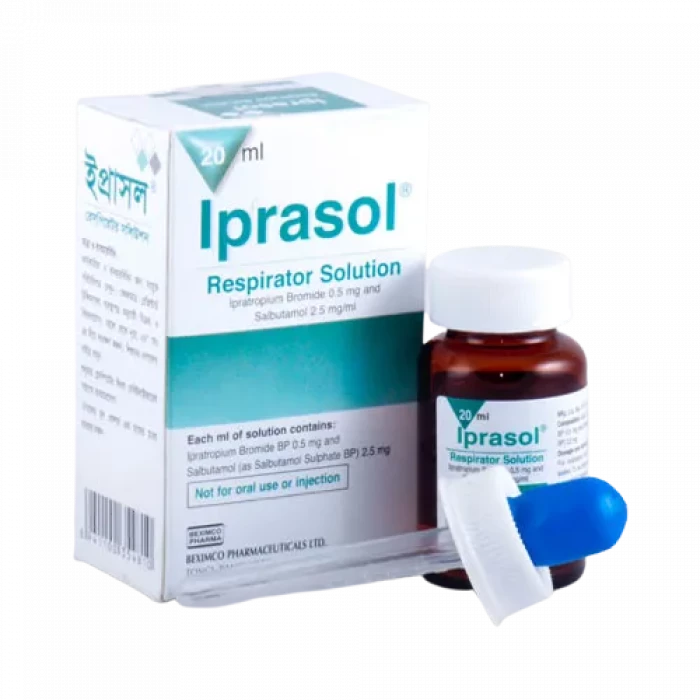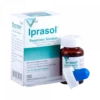IndicationIprasol Nebulizer Solution is used to treat chronic obstructive pulmonary disease (COPD) (a lung disorder in which the flow of air to the lungs is blocked). It aids in relaxing the muscles of the airways, making breathing easier. It alleviates coughing, wheezing, and shortness of breath. Your doctor will advise you on how frequently you should use your inhaler. This medicine’s effect may be noticeable after a few days, but it will not be at its peak for several weeks. This medication must be taken on a regular basis in order to be effective, so continue taking it even if you are not experiencing any symptoms.Pharmacology
Ipratropium bromide is easily absorbed after inhalation. Systemic bioavailability after inhalation is expected to be less than 10% of the dose. Following intravenous administration, the kidneys excrete 46 percent of the administered dose. The terminal elimination phase has a half-life of about 1.6 hours after intravenous administration. The medication and its metabolites have a half-life of 3.6 hours, according to radio labeling. Ipratropium bromide does not cross the blood-brain barrier.Salbutamol sulfate is rapidly and completely absorbed after inhalation or oral administration.Dosage & AdministrationA suitable nebulizer or an intermittent positive pressure ventilator can be used to administer salbutamol sulfate and ipratropium bromide solution for inhalation in the ampoule.Adults (including the elderly): Use one 3 mL ampoule four times per day in the nebulizer. If necessary, two additional treatments may be used per day.Children: Use and dosage must be determined by a physician.If additional inhalations do not produce adequate improvement, patients should be advised to consult a doctor or the nearest hospital right away if they have acute or rapidly worsening dyspnea.Step 1: Remove the ampoule’s cap. Take care to keep the ampoule upright.Step 2: Fill the nebulizer chamber with the desired amount of nebulizer solution.Step 3: If dilution is needed follow the physician?s direction.InteractionConcurrent use of beta-mimetics, systemically absorbed anticholinergics, and xanthine derivatives may exacerbate the negative effects.Concurrent administration of xanthine derivatives, glucocorticoids, and diuretics may worsen beta-agonist-induced hypokalemia. This is especially important in patients with significant airway obstruction.Digoxin users may be more prone to arrhythmias if their potassium levels are low. Serum potassium levels should be monitored in such cases.When beta-blockers are used concurrently, the bronchodilator action may be significantly reduced.ContraindicationIn patients with hypertrophic obstructive cardiomyopathy and tachyarrhythmia, as well as in patients with a history of hypersensitivity to atropine or its derivatives, or to any other component of the product, the combination of Salbutamol and Ipratropium Bromide is contraindicated.Side effects?Dryness in mouthBreathlessnessCoughTremorHeadachePalpitationsMuscle crampPregnancy & LactationPregnancy category C. Animal studies with Salbutamoi Sulphate have demonstrated a teratogenic effect. It is not known whether this medication is harmful to the fetus. No evidence of abnormalities has been reported in women receiving albuterol during pregnancy. This solution should be used during pregnancy only if the potential benefit justifies. This solution should be used with caution before childbirth in view of Salbutamol’s inhibitory effects on uterine contractions.Salbutamol Sulphate and Ipratropium Bromide are probably excreted in breast milk and their effects on neonates are not known.Precautions & WarningsA doctor should be called right away if you have acute, rapidly increasing dyspnea. Urticaria, angioedema, rash, bronchospasm, and oropharyngeal edema have all been reported as immediate hypersensitivity reactions following the administration of this solution.
Storage ConditionsKeep below 30?C temperature, away from light & moisture. Keep out of the reach of children.
20%
Discount
For Books Of March
Enter Prmotion Code







Reviews
There are no reviews yet.